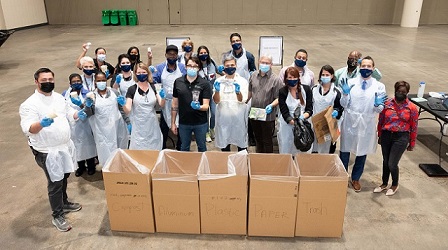 NEW ORLEANS—The New Orleans Ernest N. Morial Convention Center regularly hosts conferences, tradeshows, sporting events, and even glamorous high-profile events such as charity galas and Carnival balls. But now they are talking trash. The Convention Center recently completed their first ever Event Waste Audit, in pursuit of a Leadership in Energy & Environmental Design (LEED) certification.
NEW ORLEANS—The New Orleans Ernest N. Morial Convention Center regularly hosts conferences, tradeshows, sporting events, and even glamorous high-profile events such as charity galas and Carnival balls. But now they are talking trash. The Convention Center recently completed their first ever Event Waste Audit, in pursuit of a Leadership in Energy & Environmental Design (LEED) certification.
During the Specialty Coffee Expo on October 1, Convention Center employees (dubbed “The Trash Team”) went through over 400 pounds of a representative sample of waste materials to evaluate how well the building is diverting materials from landfills. A mix of trash, recycling, and composting bins were collected over a 24-hour period and then sorted by hand into groups (e.g. metals, plastics, compostables, landfill waste, etc.) to determine whether all materials were placed in their proper collection bins.
To earn points for a waste audit in pursuit of LEED certification, the US Green Building Council (USGBC) requires a detailed accounting of each waste stream and analysis about potential opportunities for improving the building’s overall diversion rate. The result is a waste audit report that describes how well an organization is doing managing its waste, and ways to improve.
Why a Waste Audit?
The purpose of a waste audit is to understand the make-up of waste in the facility (i.e. recyclable material, true trash waste, compostable/organic materials etc.); and to observe and analyze how accurately waste is discarded (both front of house and back of house) and to identify items that are incorrectly being discarded in the wrong collection container. For example, garbage in the recycling stream, or recyclables in the landfill waste stream.
A waste audit takes samples of waste from the building over a 24-hour period and then analyzes what can be better “diverted” from the waste stream. Diversion means keeping waste out of the landfill and into making useful products. This includes what can be recycled, composted, sold—like cardboards and pallets—or reduced in the first place.
Prior to the waste audit, the Convention Center’s Director of Sustainability, Linda Baynham, specifically targeted and refined the building’s existing educational campaigns to determine the best ways to divert more compostable material from the trash, such as evaluating the location and number of bins, the size of bins, and signage.
Adam J. Straight, Vice President of Operations said, “It was very enlightening to sort through our trash. The audit was especially important to meeting our goal of LEED Certification over the next year. Waste management is a key part of running a building in a sustainable way, and we are looking to improve our performance.”
Waste Stream Items Weighed
In addition, the Sustainable Investment Group (SIG) team sorted and weighed all waste streams and contaminants found in the recycling or organics stream, as well as any recyclable or organics that was in the true trash waste stream.
The audit demonstrated that over 52 percent of the total waste by weight was properly diverted from the landfill, according to Bradley Vogel, of SIG, the Convention Center’s LEED consultant. While this figure is commendable for the newly implemented waste diversion program, SIG provided a Waste Audit report with recommendations and next steps on how the facility can continue to improve their waste management program.
“The Convention Center is well on its way to achieving success with its waste diversion program,” said Vogel. “The waste bin signage, bag color coding policy, and willingness to sort waste back of house ensure that diverting waste from a landfill is paramount while maintaining minimal contamination. From here, the next steps are to work on the upstream solutions to rethink, reduce, and reuse waste before it even gets to the event floor. Consider ways to rethink how waste is generated from the various spaces, and consider creative ways to reuse and reduce.”
Convention Center President Michael J. Sawaya said, “Participating in this audit not only highlights the necessity of a good education campaign, but also the importance of convenient and readily accessible disposal options. It was also a great opportunity to show staff our commitment to sustainability and recycling.”
The complete Waste Audit report can be viewed on the Convention Center’s website here.





